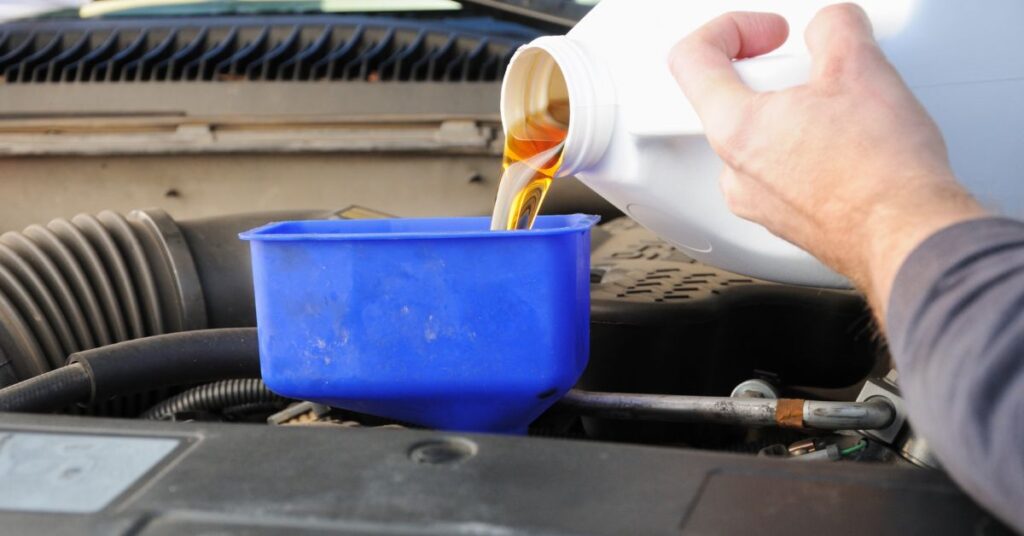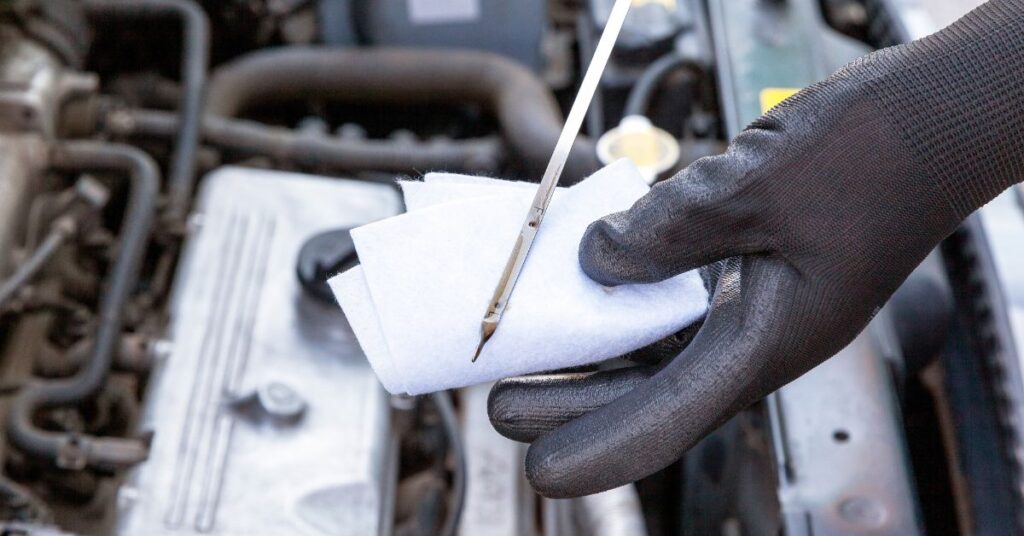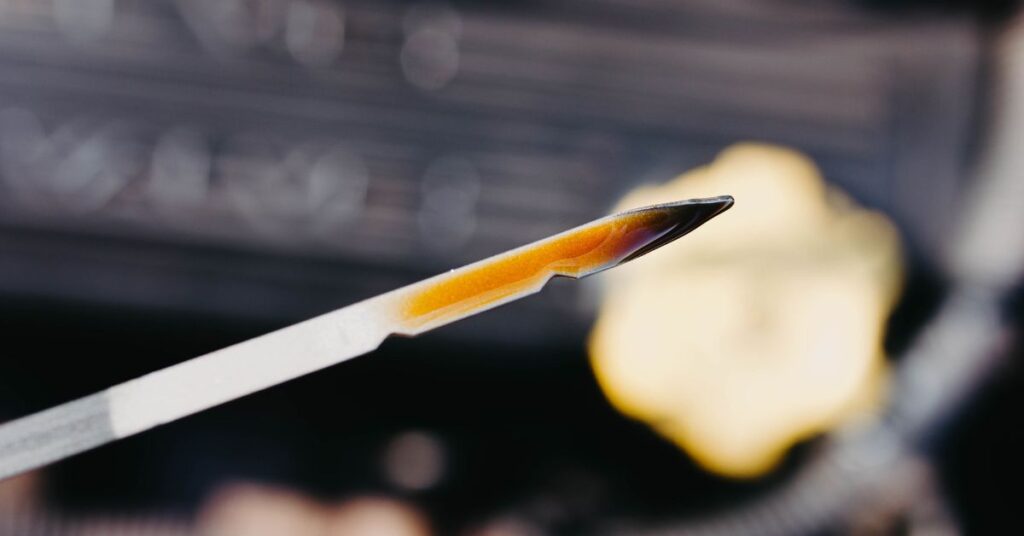Having no oil on a dipstick (or even low oil on a dipstick) is bad news. This means that you do not have enough oil in your car to lubricate your engine and you should add oil immediately.
You should not take the car anywhere until oil has been added. Likely you will need to follow this up with an oil change, but its possible there is damage to the engine.
Looking for an oil change?
We have some special offers for our readers for oil changes at Valvoline!
Click each offer below to redeem

Is there really no oil in engine when dipstick is dry?
There is still likely excess oil in the oil pan even if a dipstick is run dry. Online Mechanic Tips made a video demonstrating that there is still excess oil even if a dipstick is dry.
In the video, they estimate somewhere between 0.5 – 1 L is left as residual oil.
The dipstick doesn’t usually go all the way to the bottom of the pan. It may only touch the top two or so quarts of oil. So for smaller engines, this may leave as much as 1.5 quarts left in the oil pan, but more for larger engines.
Just because there may be oil in the engine does not mean that your engine is safe. No oil on a dipstick may indicate that there is in fact no oil in the engine.
Either way, the dipstick is telling you that you don’t have enough oil in your engine to function properly.
What happens to my engine if there is no oil on the dipstick?
If there is no oil on the dipstick, there isn’t enough oil in your engine to keep if fully lubricated. This can be very bad!
If there isn’t enough oil in the crankshaft, the oil pump may not be able to pressurize the oil and therefore will not lubricate your engine and cause serious damage and engine seizing very quickly.
It’s also possible that the oil pump may start to pump in air, which causes the oil to foam which has virtually no lubricating properties.
Another frequent symptom of low oil is engine knocking, which is a repetitive sound coming from the engine which gets louder when accelerating. There are other reasons this sound may occur, but in combination with low oil, this is an audible way in which the engine parts are not well lubricated.
Typically before serious damage occurs, the check engine light will turn on and the oil pressure will decrease. But you should not wait until this point to before you do something!
What do to if there is no oil on dipstick?
If there is no oil on your dipstick, the first thing you want to do is ADD MORE OIL!
The dipstick is telling you that there isn’t enough oil in the engine.
Unless you already have your car at the shop and are in the process of an oil change, you are going to want to leave your car where it is, get some motor oil, and add it to your vehicle.
You should start by adding one quart at a time and rechecking the level on the dipstick to make sure it is appropriately filled.
Where should oil be on the dipstick?
Oil on a dipstick should fall in between the two notches or indents at the bottom of the dipstick. There are two images below to show these markings.
The markings on the dipstick here represent the maximum and minimum oil levels for efficient lubrication of your engine.
When you are adding oil to your vehicle, you want to make sure you are measuring and recording the oil level accurately. When filling up your oil tank, follow these steps for the best results.
STEP 1
To make sure you’ve added the proper amount of oil, first add a quart to your engine and let it sit for 2 minutes.

STEP 2
Then wipe off the end of the dipstick with a paper towel.

STEP 3
Then lastly reinsert the dipstick into the vehicle and slowly remove it.
You want the oil to fill up at the dipstick between the two notches or indents at the bottom of the dipstick.

Why is there no oil on my dipstick?
After you have appropriately added oil to your engine, you want to identify why your oil is so low. The two main reasons you engine oil could be low is that you have a gross leak or your engine is consuming oil.
The first thing you should check is the last time you had an oil change. This information will provide you with valuable information that could impact leaking and consumption.
If your car is due for an oil change, then take your vehicle in as soon as possible.
You may be interested in: How long can you go without an oil change – before it’s too late?
If your oil has been in your engine too long, this can cause the gaskets and covers to become hard and then shrink, causing leaks. Regular oil provides necessary additives to keep seals and gaskets strong and in place.
Similarly, if the oil has been used beyond it’s life this will cause the oil to breakdown and evaporate quicker as the additives deplete.
Looking for an oil change?
We have some special offers for our readers for oil changes at Valvoline!
Click each offer below to redeem
If your car doesn’t seem to need an oil change, then there is likely another problem at play.
This could be some other type of leak at a gasket or seal that could come from wear and tear or gross damage. You should check the following parts to check for a leak.
- valve covers
- timing chain covers
- oil pan covers
- oil drain plug
- oil pressure sensor
- oil filter
- crankshaft seals
- head gasket
- positive crankcase ventilation seal
Another cause for oil loss is consumption of the oil in the combustion chamber. This can occur as oil enters the engine through warn out pistol rings, valve stems and seals. As an engine gets older, this issue becomes more common.
Conclusion
So what does low/no oil on a dipstick really mean?
It means that you need more oil! The dipstick is the main indication of how much oil is necessary to keep your engine well lubricated. Though there may be some residual oil still left in the pan, the manufacturer is telling you that it is not enough.
If you have no oil on your dipstick, before you do anything else, you should add oil immediately until you can return the oil level on the dipstick. You should then check your engine for damage.
It is important that you identify why you have no oil on your dipstick as well. This could be because you are in need of an oil change, you have a leak, or you are burning oil faster than anticipated. Either way, it is important to investigate what is causing the issue and fix it as necessary.





